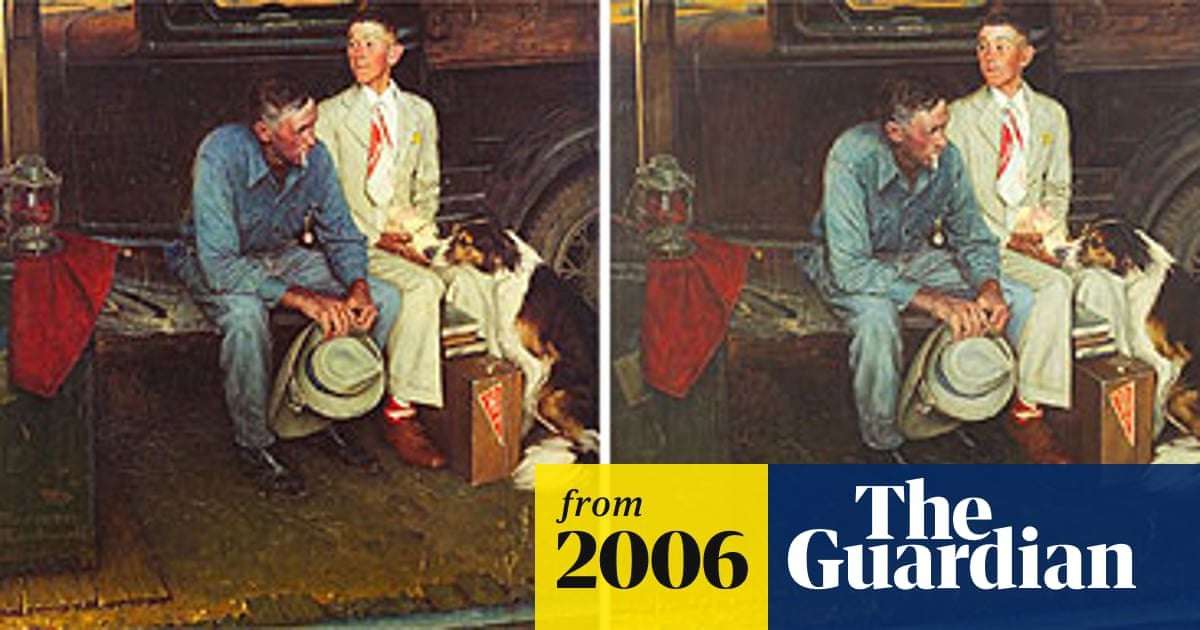Breaking Home Ties, which hangs at the Norman Rockwell Museum in Stockbridge, Massachusetts, is one of the American artist's best-known and most popular works, worth an estimated $5m on the art market. Or it would be, if Rockwell had actually painted it.
In fact, the museum's prized exhibit has been exposed as a fake, almost certainly created by the cartoonist Don Trachte, who bought the original painting from Rockwell in 1960 for a mere $900. Trachte died in 2005, but his deception was only revealed last month when his sons, Dave and Don Jr, discovered the original painting hidden in a secret compartment behind the walls of their father's house. It had lain there undisturbed, along with seven other valuable works by contemporary artists, for the best part of 35 years - the exact date is uncertain, since even now nobody knows when Trachte made the switch. "Right now, I believe he could have painted the Mona Lisa and fooled the world," says Don Jr.
Norman Rockwell painted Breaking Home Ties in 1954 for the cover of the Saturday Evening Post. The copy that hangs at the Rockwell Museum has long puzzled art experts, since it differs visibly from the printed Evening Post tear sheet. However, it was always assumed that the painting had been tarnished by restoration.
"We had lived with the tragedy of believing that this piece had been damaged all these years," says the Rockwell Museum's director, Laurie Norton Moffatt. "It's a thrill to know that the original exists. It was like having a child come home. The instant you look at it, you know."
Both paintings, the original and the copy, are now on display together. However, the greatest mystery remains: why did Trachte, a respected cartoonist and a close friend of Rockwell, forge a set of paintings that he already owned?
It is most likely that he painted the fakes in the 1970s, before or during his divorce from his wife Elizabeth. "He was worried that they could be taken away from the family," Don Jr suggests. "I don't think he knew what the heck was going to happen. Maybe the lawyers would have said the best thing was to sell the paintings."
Whatever the reason for Trachte's ruse, it appears that he left the world a clue: a self-portrait parody of Breaking Home Ties, with himself as the morose father and his famous cartoon character Henry as the boy. It now hangs with the original, and the fake, as part of a special exhibition at the Rockwell Museum.

Xylorios on January 7th, 2020 at 15:16 UTC »
Are we going to ignore the fact that the painting is titled "Breaking Home Ties" and the story is about him breaking ties with his home ?
NotSureWTFUmean on January 7th, 2020 at 14:44 UTC »
Dayum, that's diabolical genius! Friend of mine has an incredible tool collection he built of over the years worth a lot of money to have to replace and was going through a divorce. During the first weeks of of it (It was amicable) they were still in the same house and she made a small quick comment about how good his tool collection was and remarked how she'd need her own tools once they went their separate ways. The next day he showed up at my place and I ended up with my garage full of all his best power tools lol. He got away with it because she really had no idea about tools so wouldn't have known what to look for or whether anything was missing
barath_s on January 7th, 2020 at 12:22 UTC »
Donald Trachte, the cartoonist, worked on the Sunday edition of Henry. The original hidden rockwell which he forged, was discovered and sold for $15.4m. He had bought it for $900 in 1962. Both versions were displayed together on a museum tour before the auction sale.
The seven other paintings are by artists including Mead Schaeffer, Gene Pelham, and George Hughes.
The divorce agreement signed in 1973 left the 8 paintings to the 3 sons of the cartoonist, with Trachte's ex-wife allowed to hang 5 in her house and Trachte 3 in his.
edit: reworded slightly to clarify that the replica had been lent on display earlier at the Rockwell museum, but that after the original was discovered, both went on display before the original was sold at auction to an anonymous buyer.